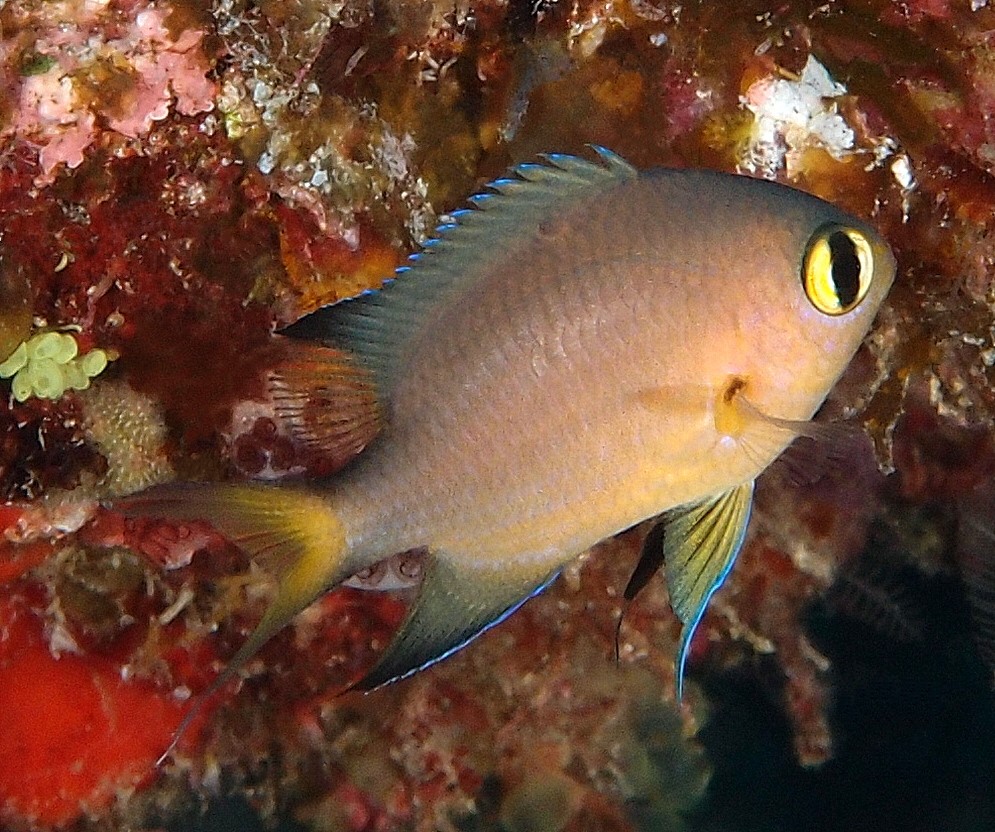PYCNOCHROMIS ATRIPES - (FOWLER & BEAN, 1928)
Actinopterygii (Gigaclass) > Actinopteri (Class) > Teleostei (Subclass) > Blenniiformes (Order) > Pomacentridae (Family) > Chrominae (Subfamily) > Pycnochromis (Genus)
Chromis à nageoires foncées, Dark-fin chromis, Darkfin chromis, Dusky puller, Hireguro-suzumedai, ヒレグロスズメダイ, 腋斑光鰓魚, 腋斑光鳃鱼, 黑鰭光鰓雀鯛,
Synonyme
Chromis atripes (Fowler & Bean, 1928)
--------------------------
Description
Dorsal spines (total): 12; Dorsal soft rays (total): 12-14; Anal spines: 2; Anal soft rays: 12-13; Pectoral fin rays: 15-17; Lateral line scales: 14-16; Gill raker: 24-29; Body depth: 1.7-2.0 in SL. Caudal fin lobes ending in filaments. With prominent pores of lateralis system on head. Max. length: 9.0 cm TL. Depth range: 2 - 40 m, usually: 10 - 25 m.
Color
Body orangish brown with faint light bluish to lavender iridescence on lower head and thorax; Darkly-edged orbit; Iris yellowish with a blackish blotch dorsally and ventrally. Eyes large. Preopercular margin smooth. Blackish spot on dorsal and anal fins confined at rear base; Upper and lower edges of caudal peduncle and fin blackish; Wedge-shaped black spot on pectoral base.
Etymology
Pycnochromis: from ancient Greek, puknós = dense, compact, thick. Referring to “very smooth” head of Pycnochromis vanderbilti, the “edges of the suborbitals, preopercle and opercle little distinct” + from chromis: from Greek, chroemo = to neigh. A name dating to Aristotle, referring to a drum (Sciaenidae) and its ability to make noise; Later applied to this damselfish and subsequently expanded to embrace dottybacks, cichlids and wrasses (all perch-like fishes once thought to be related).
atripes: from Latin, ater = dull black (as opposed to niger, shining black); dark + from Latin, pes = a foot, (zoology) any equivalent body part of an animal. Referring to black ventral fins.
Original description: Chromis atripes Fowler & Bean, 1928 - Type locality: Sablayan, Mindoro, Philippines.
Distribution
Eastern Indian Ocean, western Pacific: Christmas Island and Indonesia east to Marshall Islands and Fiji, north to Amami Islands (southern Japan), south to northern Australia and New Caledonia.
Biology
Adults inhabit coral rich areas of outer reef passes and slopes. They occur singly or in small groups near the bottom. Oviparous, distinct pairing during breeding. Eggs are demersal and adhere to the substrate. Males guard and aerate the eggs. Aquarium fish.
Similar species
Last update: 19, September 2021
Chromis à nageoires foncées, Dark-fin chromis, Darkfin chromis, Dusky puller, Hireguro-suzumedai, ヒレグロスズメダイ, 腋斑光鰓魚, 腋斑光鳃鱼, 黑鰭光鰓雀鯛,
Synonyme
Chromis atripes (Fowler & Bean, 1928)
--------------------------
Description
Dorsal spines (total): 12; Dorsal soft rays (total): 12-14; Anal spines: 2; Anal soft rays: 12-13; Pectoral fin rays: 15-17; Lateral line scales: 14-16; Gill raker: 24-29; Body depth: 1.7-2.0 in SL. Caudal fin lobes ending in filaments. With prominent pores of lateralis system on head. Max. length: 9.0 cm TL. Depth range: 2 - 40 m, usually: 10 - 25 m.
Color
Body orangish brown with faint light bluish to lavender iridescence on lower head and thorax; Darkly-edged orbit; Iris yellowish with a blackish blotch dorsally and ventrally. Eyes large. Preopercular margin smooth. Blackish spot on dorsal and anal fins confined at rear base; Upper and lower edges of caudal peduncle and fin blackish; Wedge-shaped black spot on pectoral base.
Etymology
Pycnochromis: from ancient Greek, puknós = dense, compact, thick. Referring to “very smooth” head of Pycnochromis vanderbilti, the “edges of the suborbitals, preopercle and opercle little distinct” + from chromis: from Greek, chroemo = to neigh. A name dating to Aristotle, referring to a drum (Sciaenidae) and its ability to make noise; Later applied to this damselfish and subsequently expanded to embrace dottybacks, cichlids and wrasses (all perch-like fishes once thought to be related).
atripes: from Latin, ater = dull black (as opposed to niger, shining black); dark + from Latin, pes = a foot, (zoology) any equivalent body part of an animal. Referring to black ventral fins.
Original description: Chromis atripes Fowler & Bean, 1928 - Type locality: Sablayan, Mindoro, Philippines.
Distribution
Eastern Indian Ocean, western Pacific: Christmas Island and Indonesia east to Marshall Islands and Fiji, north to Amami Islands (southern Japan), south to northern Australia and New Caledonia.
Biology
Adults inhabit coral rich areas of outer reef passes and slopes. They occur singly or in small groups near the bottom. Oviparous, distinct pairing during breeding. Eggs are demersal and adhere to the substrate. Males guard and aerate the eggs. Aquarium fish.
Similar species
- Acanthochromis polyacanthus (Bleeker, 1855) - Reported from New Caledonia - Link to the species (here). Best distinguished by 17 dorsal spines, highest number in the family. This fish has a number of color variants, and ranges from whitish to all brown or dark grey, sometimes with a white tail.
- Azurina elerae (Fowler & Bean, 1928) - Reported from New Caledonia - Link to the species (here).
- Azurina lepidolepis (Bleeker, 1876) - Reported from New Caledonia - Link to the species (here).
- Chromis ternatensis (Bleeker, 1856) - Reported from New Caledonia - Link to the species (here).
- Pycnochromis amboinensis (Bleeker, 1871) - Reported from New Caledonia - Link to the species (here).
Last update: 19, September 2021
